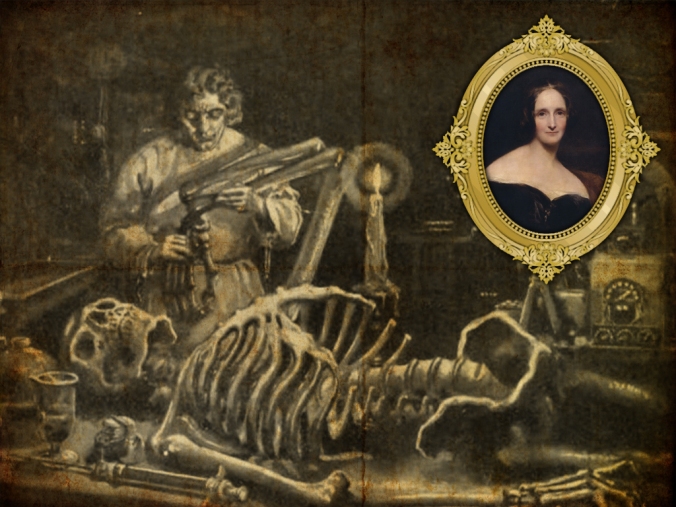A strange gathering of intellectual luminaries during one “haunted summer” produced one of literature’s most enduring creations.
Frankenstein’s monster is one of the most ubiquitous characters in popular culture, appearing everywhere from movies and novels to children’s toys and cereal boxes. Though the image we have of the lumbering creature today—greenish skin, square head, beetling brow, ropy scars and neck bolts—has been largely formed by Boris Karloff’s stunning portrayal in the Universal horror films of the 1930s, in the beginning, the monster was literally dreamed into existence under rather eerie circumstances by an eighteen-year-old girl.
Summer in Switzerland
It was May 14, 1816. Romantic poet Percy Bysshe Shelley and his “wife” Mary (the couple only married later that year, though Mary already used his last name) had been invited by friend and fellow poet Lord Byron to visit him at a rented chateau, Villa Deodati, on Lake Geneva in Switzerland. Also joining the festivities were Mary’s stepsister Claire Clairemont—who was pregnant with Byron’s child and was trying to get back into his good graces—and Byron’s personal physician John Polidori.
The gathering apparently started out quite idyllic—the friends spent long hours writing, discussing weighty ideas, and boating in the lake. But a short time after the group arrived, the weather took a bizarre turn, and it seemed the streaks of lightning and the torrents of rain would never cease. Mary and the others were confined to the house for many days.
Ghost Stories
More reading and discussion ensued. Particular topics of conversation included the early evolution theories of Erasmus Darwin, as well as the new science of galvanism. Also contributing to the entertainment of the group was a book of German ghost stories called Fantasmagoria, which the friends took turns reading aloud.
The combination of the macabre tales and the isolating weather seemed to have strange effects on everyone present; Percy Shelley, at one point, succumbed to visions that sent him screaming from the room. Later, Shelley claimed that Byron’s reading of the Samuel Taylor Coleridge poem “Cristabel” had brought to mind the image of a woman with eyes instead of nipples, which horrified him.
Setting to Work
Some time after this incident, the group decided that they would each try to write their own ghost story. Most set to work immediately and produced tales of varying quality. Byron wrote a story fragment titled “The Burial,” which was later published as a postscript to his narrative poem Mazeppa. Shelley wrote a tale called “The Assassins,” which apparently never saw the light of day (though his poem Mont Blanc, written around the same time, was published later that year). Dr. Polidori wrote “The Vampyre,” later expanded to novel length, which was the first vampire story published in English and which some speculate might have been an inspiration for Bram Stoker’s Dracula, written 78 years later.
The Monster Is Born
Mary Shelley, however, couldn’t think of an idea for a story, and had to respond with a frustrated “No” when asked by the others if she had begun work on it. But then, one night, she had a terrible nightmare. She woke violently amid the sounds of the storm howling outside. The dream had been so vivid that she had a difficult time believing it hadn’t been real. Since she was too shaken to sleep, she began writing down her dream, in which “a pale student of the unhallowed arts” used bits of corpses to create a man. “By the glimmer of the half-extinguished light,” she wrote, “I saw the dull yellow eye of the creature open; it breathed hard, and a convulsive motion agitated its limbs.”
Mary’s terrifying dream was described verbatim in the story she presented to the others. Though the first draft was only about 100 pages long, Percy loved the story and encouraged Mary to flesh it out. She did, and two years after the strange events at Lake Geneva, the story was published as Frankenstein, or the Modern Prometheus, thus introducing one of literature’s most frightening figures to the world at large.

Reblogged this on hocuspocus13 and commented:
jinxx 🍀 xoxo
LikeLike
It was an amazing feat by Mary Shelley, to come up with “Frankenstein.” Offhand I don’t know how old she was when she wrote it; but it’s still here, and that’s what counts.
LikeLiked by 1 person
I believe she was only 18, which makes it even more impressive. The stuff I wrote when I was 18 was just…dire. Haha.
LikeLike
Betcha mine was worse!
LikeLiked by 1 person
I’d like to answer this challenge, but the 18-year-old me, while not great shakes as a writer, at least had enough wherewithal to chuck her literary abominations in the garbage. 🙂
LikeLike